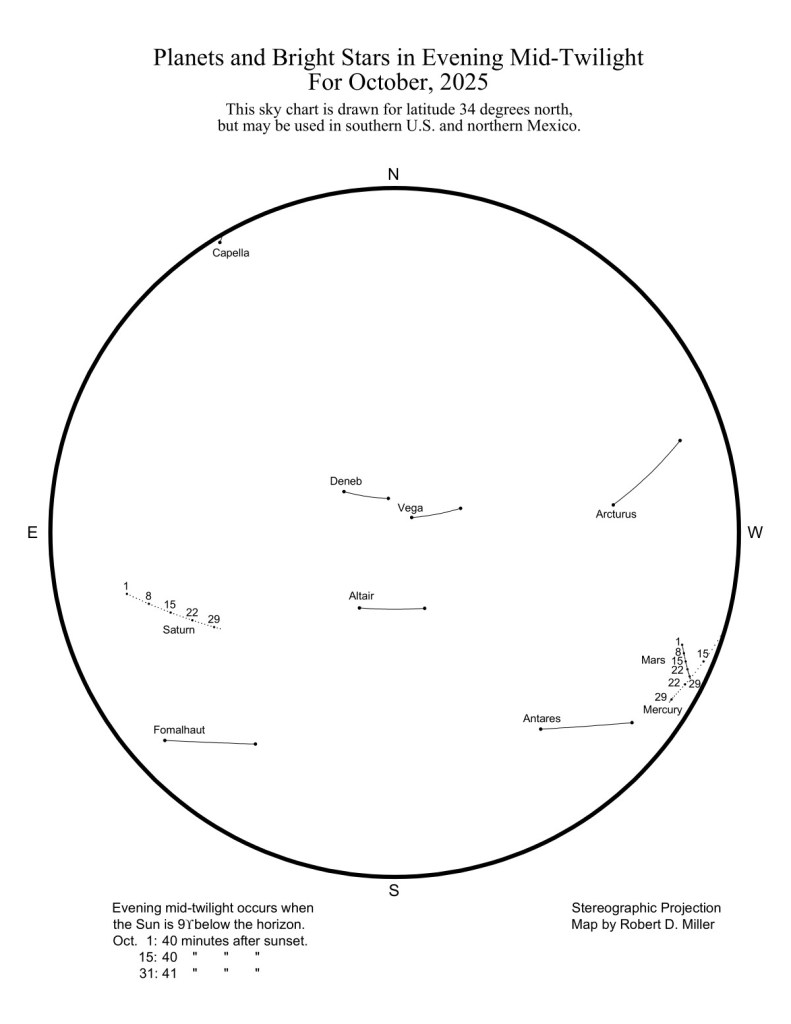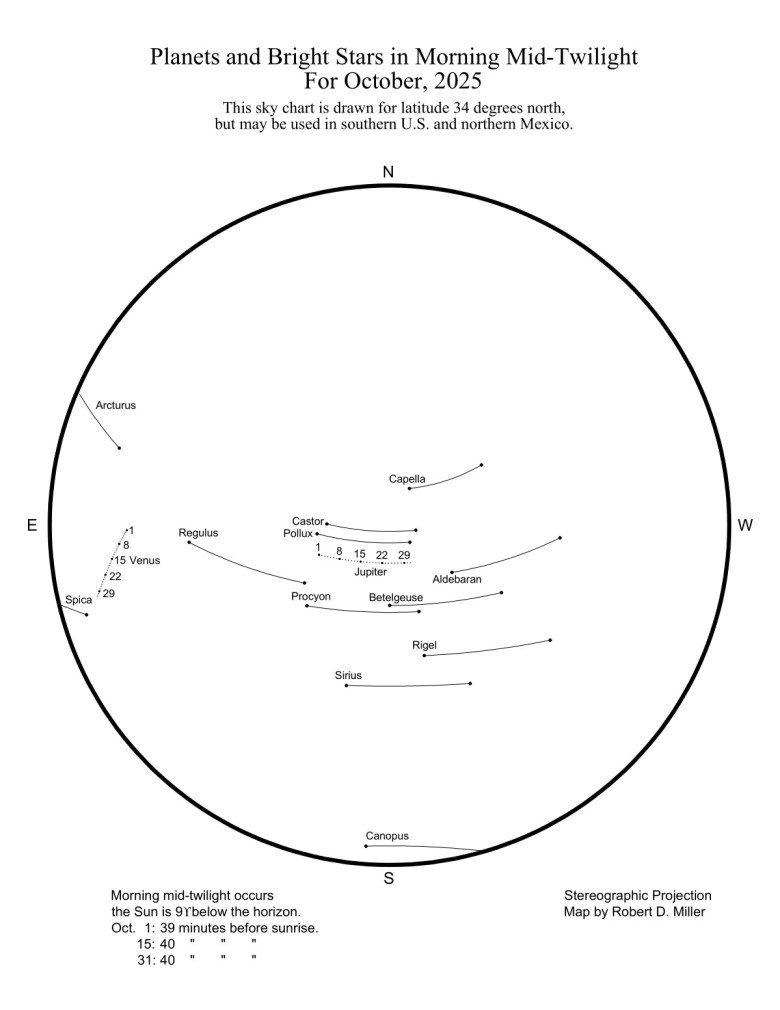
In the evening sky, one hour after sunset, golden Arcturus, sinking in the west to west-northwest, and blue-white Vega, not far west to west-southwest of overhead, are the two most prominent objects.
Next in brilliance is Saturn, climbing through the east-southeast toward southeast as this month progresses. Other bright stars are Altair and Deneb, completing the Summer Triangle with Vega; and the red supergiant star Antares, heart of Scorpius, in the southwest, sinking very low before month’s end.
Here are 10 things to watch for in October’s nighttime and early-morning skies.
• Through a telescope, Saturn’s rings are presented 1.4° to 0.6° from edge-on to Earth during October, and so appear as a narrow line, almost like a needle piercing a ball of yarn. In 2032, we’ll have our most open view, nearly 27° from edge-on. Titan, Saturn’s biggest moon, in the same plane as the rings, appears as an eighth-magnitude star, at most, four ring-lengths from the nearer ring edge. This month, in a dark sky, Neptune appears at magnitude 7.8, 3.1° to 4.1° from Saturn. But a finder chart is needed to identify it.
• Arcturus is 33° due north of the sun on Oct. 29, placing it 33° directly above the midday sun on that date. It’s up much longer than the sun, so you can spot it very low in the east-northeast an hour before sunrise, and very low in the west-northwest an hour after sunset on that same date. On what date will you first spot Arcturus in the morning, and on what date in early November will you last see it in the evening?
• The moon is visible an hour after sunset daily Oct. 1-8, and again Oct. 23 or 24 through Nov. 6. Watch the moon pass Saturn on Oct. 5 and Nov. 1, and Antares on Oct. 24.
• On the evening of Oct. 9, the moon will pass through the Pleiades star cluster. Use binoculars to see some of its stars around the moon, and use a telescope to see stars pop out along the dark edge of the moon. From Palm Springs, that will happen at 9:08, 9:31 and 9:46 p.m. PDT.
• In the morning sky, one hour before sunrise, the brightest starlike objects are Venus, very low in the east to east-southeast; Jupiter, high in the southern sky; and the Dog Star, blue-white Sirius, twinkling noticeably in the south-southeast to south-southwest. (You can confirm it’s Sirius by noting that the belt of Orion, the Hunter, extended, points to it.)
• Follow the moon an hour before sunrise each morning Oct. 6-19, and watch it wane from full, low in the west on Oct. 6; through Taurus, the Bull, passing the Pleiades, Aldebaran and Hyades, and the Bull’s horns Oct. 9-11. Continuing eastward, the moon enters Gemini on Oct. 12, and forms attractive patterns with bright Jupiter and that constellation’s “Twin” stars, Pollux and Castor, on the next two mornings. By the morning of the 16th, the crescent moon is in the eastern sky, very close to Regulus, heart of Leo, the Lion. On the 18th, the 8 percent crescent appears 13° to the upper right of Venus, and on the 19th, the 4 percent crescent stands just 3°-4° to Venus’ lower right.
• On the morning of Oct. 13, when the moon passes last-quarter phase and appears half-full near Jupiter, the moon is cutting across the Earth’s orbit just 3 1/2 hours ahead of us in our motion around the sun. On Oct. 17, Jupiter lies directly ahead of Spaceship Earth in our orbit around the sun. In coming months, we’ll overtake slower-moving Jupiter, and it will appear at opposition, 180° from the sun, in early January, around the same date fast-moving Venus has moved around to the far side of the sun. So, between now and early January, watch Jupiter sink toward the western horizon at dawn, while Venus sinks very low in the eastern sky week by week, and becomes too close to the sun to be seen.
• The moon might be seen on one additional morning beyond Oct. 19, but you’ll have to look about a half-hour before sunup, and need a very clear sky and an unobstructed view. Using binoculars on Oct. 20, look for a very thin 1 percent crescent, 10° to the lower right of Venus. The moon will be only 10° from the not-yet-risen sun, and will be 23 hours before new from Palm Springs.
• This year, the peak of the Orionid meteor shower coincides with the date of new moon, Oct. 21. Ideal! The best time to look is about five hours to 90 minutes before sunrise.
• On mornings when the moon is absent or not bright, Uranus, of magnitude 5.6, can be spotted with binoculars in the same field of view as the Pleiades cluster. In October, the planet is 4.3° south-southeast of 2.9-magnitude Alcyone, the Pleiades’ brightest star, and 3° to 2.1° east-northeast of the 5.7-magnitude star 13 Tauri. Note the slightly fainter 6.1-magnitude star 14 Tauri 21 arcminutes (about 1/3 of a degree) east of 13.
The Astronomical Society of the Desert will host a star party on Saturday, Oct. 18, at Sawmill Trailhead, a site in the Santa Rosa Mountains at elevation 4,000 feet. For more information, including a maps and directions to the observing site, visit astrorx.org.
Robert Victor originated the Abrams Planetarium monthly Sky Calendar in October 1968 and still helps produce an occasional issue. He enjoys being outdoors sharing the beauty of the night sky and other wonders of nature. Robert Miller, who provided the evening and morning twilight charts, did graduate work in planetarium science and later astronomy and computer science at Michigan State University, and remains active in research and public outreach in astronomy.

October Astronomy: The Month’s Skies Bring a Lot of Moon-Star Rendezvous—and an Ideally Timed Meteor Shower! is a story from Coachella Valley Independent, the Coachella Valley’s alternative news source.

